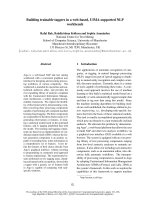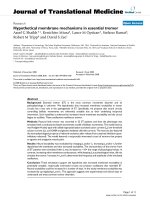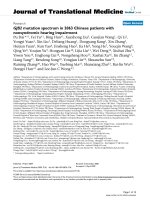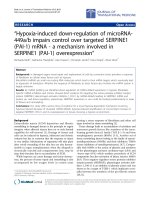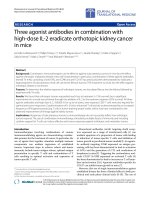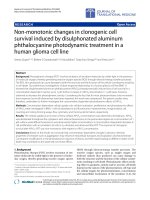báo cáo hóa học:" Viral load testing in a resource-limited setting: quality control is critical" potx
Bạn đang xem bản rút gọn của tài liệu. Xem và tải ngay bản đầy đủ của tài liệu tại đây (253.51 KB, 6 trang )
SHOR T REPOR T Open Access
Viral load testing in a resource-limited setting:
quality control is critical
Jane Greig
1*
, Philipp du Cros
1
, Derryck Klarkowski
2
, Clair Mills
2
, Steffen Jørgensen
3
, P Richard Harrigan
4
and
Daniel P O’Brien
2
Abstract
Background: World Health Organization guidelines now recommend routine use of viral load testing, where
available, for patients receiving antiretroviral treatment (ART). However, its use has not been routinely implemented
in many resource-limited settings due to cost, availability and accessibility. Viral load testing is complex, making its
application in resource-limited settings challenging. We describe the issues encountered by Médecins Sans
Frontières (MSF) when using routine viral load testing in a large HIV programme in sub-Saharan Africa.
Methods: Between October 2005 and August 2006, more than 1200 patients on ART had viral load tests at
baseline and at three-month intervals performed by a local reference laboratory that was quality assured by an
experienced international institution. Concerns with reliability of results halted testing. The quality control measures
instituted with a second laboratory and outcomes of these were documented.
Results: In 2005 and 2006, only 178 of 334 (53%) previously ART-naïve patients tested after six to 12 months of
treatment had viral loads of less than 1000 copies/mL. Similar MSF programmes elsewhere demonstrated
virological suppression rates of more than 85%, and duplicate testing showed unacceptable discordance.
Laboratory problems encountered included: disregarded quality control; time delays; requirement for retesting; and
duplicate sample variations. Potentially harmful clinical outcomes of inaccurate viral load results include:
unnecessary ART regimen changes; unnecessary enhanced adherence counselling after “false failures"; and
undetected virological failure.
Conclusions: Viral load testing performed without rigorous quality control carries the risk of erroneous and
potentially damaging results. Viral load testing should be utilized only if robust quality assurance has been
implemented. Our experience in this and other settings led to the development of a guide for assessing the
suitability of a laboratory for viral load testing that can be used to help achieve reliable results.
Background
Viral load (VL) testing is the only definitive method for
early detection of antiretroviral treatment (ART) failure
[1,2]. HIV treatment can be managed without routine
laboratory assessment [3], but CD4 monitoring allows
for evaluation of disease progression [4], and VL testi ng
can increase adherence and facilitate timely switching of
failing regimens, minimizing the development of resis-
tance [5]. VL testing has not been routinely implemen-
ted in resource-limited settings due to cost, complexity,
availability and accessibility. Calls for widespread VL
test use are increasing, and 2009 World Health Organi-
zation (WHO) guidelines recommend the routine use of
VL testing where available [6,7]. However, obtaining
quality controlled and reproducible results for even sim-
ple laboratory tests in resource-limited settings is chal-
lenging [8,9]. Inaccurate or delayed results can have
serious consequences for patients and programmes.
An HIV programme run by Médecins Sans Frontières
(MSF) in an urban resource-limited sett ing in sub-
Saharan Africa offered free medical care and psychoso-
cial support to people living with HIV/AIDS. Patients
could self-refer for on-site counselling and testing, or
were referred by other healthcare providers. Over a pe r-
iod of more than five years, MSF registered more than
2700 adults living with HIV/AIDS and provided ART to
* Correspondence:
1
Manson Unit, Médecins Sans Frontières, London, UK
Full list of author information is available at the end of the article
Greig et al. Journal of the International AIDS Society 2011, 14:23
/>© 2011 Greig et al; licensee BioMed Central Ltd. This is an Open Access article distributed under the terms of the Creative Commons
Attribution License ( which permits unres tricted use, distribution, and re product ion in
any medium, provided the original work is properly cited.
almost 2000. Most were women (63%), and many sur-
vived on less than US$2 per day. We describe the
experience of routine VL testing for patients receiving
ARTinthisHIVprogrammeintwoseparateseriesof
events between 2005 and 2008 (Figure 1).
Methods
Between October 2005 and August 2 006, more than
1200 patients on ART had VL tests at baseline, and
every three months thereafter. Samples were collected in
EDTA tubes, centrifuged for 10 minutes at 800 × g and
2005/06
2007/08
Routine VL testin
g
b
y
Lab 1
Concerns about result validity due to
low virological suppression rates
Du
p
licate sam
p
les sent for external QC
(Lab 1 vs. Lab 2) (Lab 1 vs. Lab 3)
Poor QC results, Lab 1 unwilling to
share internal QC data, testing halted
Lab 2 assessed and triplicate samples sent for external QC
(Lab 2 vs. Lab 4 vs. Lab 5)
Acce
p
table QC results and Lab 2 willin
g
to share internal QC data
Delay in testing; results released from lab as valid but release of QC
data for test runs further dela
y
ed
Additional appointments required for
>300 patients to receive delayed result
59% (363) of initial results released by
Lab 2 found invalid after QC review by
Blinded du
p
licates
included in all
s
p
ecimen sets
Recall 363 patients for replacement
sam
p
les to retest (
g
reater sam
p
le volume
obtained henceforth
)
Further delays obtaining test kits and technical support for
instrument maintenance
Further invalid test runs identified (before result release) and
repeat testing required
Action b
y
laborator
y
to address some issues
Viral load testin
g
of
p
atients recommenced
Lab 1 assessed for laborator
y
standards
Figure 1 Flow of events. VL - Viral load. QC - Quality control
Greig et al. Journal of the International AIDS Society 2011, 14:23
/>Page 2 of 6
the plasma stored in sterile tubes at -20°C for less than
eight weeks. Samples were measured at a local reference
laboratory (Lab 1) using Roche Cobas Amplicor HIV-1
Monitor Test v1.5 and Cobas Amplicor Analyser (Roche
Diagnostics, Basel, Switzerland), with preparation of fro-
zen plasma in accordance with the Amplicor v1.5 man-
ual guideline.
Prior to use, Lab 1 was assessed by an MSF laboratory
scientist for: training of personnel; appropriate labora-
tory facilities; workflow; separation of areas for sample
preparation, reagent preparation and sample analysis;
backup power for laboratory freezers and refrigerators;
temperature monitoring guidelines; cleaning guidelines
for different laboratory work areas; and a ccess to water
of appropriate quality. The laboratory was found to be
of a high standard, and was supported and quality
assured by an international institution with experience
in VL testing, with tests performed by trained staff
already experienced with the procedures. No external
quality control was organized by MSF.
Due to concerns regarding the validity of results, sam-
ple collection and preparation procedures were reviewed
and reinforced, and additional samples were tested as
blinded duplicates: 21 duplicates were sent to Lab 1 and
another laboratory in-country (Lab 2, which was inter-
nationally supported, experienc ed in performing VL
tests, and had good facilities found during assessment
by an MS F laboratory scie ntist; VL testing was per-
formed using Bayer Versant HIV-1 RNA 3.0 bDNA
assay with Bayer System 340 bDNA Analyzer [Bayer
Diagnostics, Tarrytown, NY, USA] with samples pre-
pared according to the Versant guidelines). A further 29
duplicates were sent to Lab 1 and a reference laboratory
in another sub-Saharan African country (Lab 3) that
used Roche Amplicor. The differences between paired
log VL results and the mean absolute differences for all
samples were calculated, and the limits of agreement
between laboratories compared using the method of
Bland and Altman [10]. The results o f this quality con-
trol ended the first period of VL testing.
In mid 2007, the internationally supported Lab 2 was
re-assessed by an MSF laboratory scientist, and external
qua lity control of VL performance was undertaken with
the lab’s con sent. Ten triplicate specimens, obtained
with patient consent and prepared as previously, were
sent to laboratories in Europe (Lab 4 and Lab 5) that
used COBAS AmpliPrep/COBAS TaqMan HIV-1 Tests
(Roche Diagnostics, Basel, Switzerland). This process
involved approximately one week of staff time, cost
around US$1500 for testi ng and sending frozen samples
with dry ice and triple-packaging by courier, and
incurred considerable difficulties in ensuring unbroken
cold chain conditions.
Results were compared as for the e arlier duplicate
testing. After an acceptable outcome of this quality
review, VL tests were performed on all patients after at
least six months on ART. Specimens were labelled with
patient name, ID code and date of collection. Samples
were sent in large ba tches with both electronic and
printed lists of these details, all of which were cross
checked a t the time of specimen storage and again
when samples were shipped frozen on ice. Results were
provided on these lists, both electronically and printed.
Ethics approval
After consideration of the MSF Ethics Review Board fra-
mew ork crit eria, this paper was assessed as not needing
ethics approval. T he work described was undertaken as
part of routine programme work and analyzed retro-
spectively. Neither the programme nor individuals have
been identified.
Results
In 2005 and 2006, 178 of 334 (53%) previously ART-
naïve patients tested by Lab 1 after six to 12 months of
treatment had VLs of less than 1000 copies/mL. How-
ever , only 4% showed evidence of immunological failure
according to 2006 WHO guidelines [11]. Virological
suppression rates of less than 1000 copies/mL in similar
MSF programmes in other countries using standar dized
treatment protocols were higher than 85% [12,13], and
in a revie w of programmes in sub-Saharan Africa, were
above 76% [14].
Tolerating variation of up to 1.0 log difference in
results (to allow for differences in the test m ethods
used), there was substantial discordance in results of
duplicate samples tested by Lab 1 and comparison
laboratories (Table 1): results of 13 (62%) samples sent
to Lab 2 and 14 (48%) sent to Lab 3 were outside the
expected range of difference. Lab 1 refused to provide
internal quality control data on future test runs, or to
receive and test blinded duplicate samples. Therefore,
use of that laboratory was discontinued and VL testing
halted. Clinicians were instructed to consider all pre-
vious VL test results from Lab 1 invalid (more than
2500 tests on more than 1500 patients at various stages
of treatment).
In 2007, VL testing recommenced in order to review
patient status and reassess programme virological sup-
pression rates. Prior to commencement of testing,
acceptable external quality control results were obtained
for Lab 2 (Table 1) and agreement reached that internal
quality control results for each test run would be pro-
vided (calibration curve and positive controls).
Results from the first eight test runs (614 samples)
performed by Lab 2 in 2007 were released to the
Greig et al. Journal of the International AIDS Society 2011, 14:23
/>Page 3 of 6
programme as valid, but quality control data to verify
this were not released concurrently. MSF received VL
results from the test runs on average 27 days (range 5-
69) after sample receipt by Lab 2, but the internal qual-
ity control data were received a further 34 days (range
25-42) later, despite repeated requests. Reasons for VL
result delays included laboratory stock shortages caused
by delays in importing test kits and a lack of in-country
technical support for instrument maintenance and
repairs. As a result, more than 300 of the 614 patients
tested in the first batch did not receive their VL results
at their scheduled follow-up appointment, and clinicians
could not use the information for optimum care.
When eventually released, quality control data showed
363 (59%) of the initial 614 samples were invalid
because calibration curves or positive controls were out-
side acceptable limits. These faults were only rec ognized
when data were examined by MSF staff and external
international advise rs; the expert interpretation was
comm unicated to Lab 2 and the service agreemen t con-
ditions were further clarified. The official release of
results by Lab 2 combined with the delay in receiving
quality control data meant that some patients received
inaccurate results. Seventy-eight of the 363 patients
from these invalid test runs were told that their VLs
were greater than 1000 copies/mL, which was the pro-
ject criteria for enhanced adherence counselling,
whereas other result s might have been inaccuratel y low.
Lab 2 blamed calibration errors on power failures and
an inverter too weak to prevent interruptions when
switching from national power to generator. The initial
sample volume requested by Lab 2 was inadequate for
retesting, and the 363 patients had to be recalled for
repeat venepuncture. Of the first 124 of these samples
retested, 52 (42%) were in a second invalid run and
required further repeat testing.
Sending samples internationally for ongoing quality
control was not feasible because of the time, logistics
and expense involved. Instead, around 10% of samples
after the initial eight test runs were sent in blinded
duplicate to Lab 2. Of 46 initial sample pairs in test
runs with acceptable quality control, the result for seven
(15%) duplicate pairs was greater than 1.0 absolute log
difference (maximum 2.7 log).
Discussion
Although we support the WHO recommendations on
routine VL testing in principle, our results question the
feasibility of safe implementation in resource-limited
settings with current technology in the absence of real-
time review of quality control data by an experienced
third party. Inaccurate results and quality control delays
created the potential for HIV patients to be attributed
with “false virological failures” . This caused confusion
and distress for patients, since ART appeared to be fail-
ing despite potentially optimal adherence.
Extra appoint ments were also needed, which increased
time and transport costs. ART might also have been
switched to second-li ne unnecessarily. No regimens were
changed on the basis of invalid 2007 results; however, on
file review, three changes in 2006 were possibly influ-
enced by VL results later deemed invalid. Second-line
treatment carries an increased pill burden and cost, and
if true virological failure occurred later, patients might be
assumed to have no ef fective regimens in the a bsence of
third-line ART. Importantly, poor VL performance may
have resul ted in false negative results, where pa tients
with virological failure were not detected, putting them
at risk of severe clinical illness and antiviral resistance.
Retes ting patient s because of quality control problems
was a burden for them and for programme staff, espe-
cially as some patients had to be reca lled to discuss
Table 1 Results of duplicate sample tests in testing and external quality control laboratories
Lab 1 vs.
Lab 2
2006
Lab 1 vs.
Lab 3
2006
Lab 2 vs. Lab 4
vs. Lab 5*
2007
Number of sample sets 21 29 10
Range of log VL results reported ND-6.1 ND-5.7 ND-4.6
N (%) of duplicate samples with difference in log VL result >1.0 13 (62%) 14 (48%) 1 (10%)
Mean (range) absolute difference in log VL result 1.1 (0.0-2.8) 1.2 (0.0-3.1) 0.2 (0.0-1.2)
Limits of agreement of tests (log VL result)
†
-4.777 to 0.801 -3.089 to 3.246 -0.796 to 0.848
False negatives: N (%) VL undetectable in testing lab but >1000 copies/mL in QC
laboratory
[same comparison but >5000 copies/mL]
0 5 (17%)
[5 (17%)]
0
False positives: N (%) >1000 copies/mL in testing lab but undetectable in QC
laboratory
[same comparison but >5000 copies/mL]
6 (29%)
[1 (5%)]
8 (28%)
[5 (17%)]
0
*Samples were sent in triplicate to Lab 2, Lab 4 and Lab 5. VL = Viral load. QC = Quality control. ND = Not detectable.
†Bland Altman comparison [10]
Greig et al. Journal of the International AIDS Society 2011, 14:23
/>Page 4 of 6
released, then invalidated, results. This led to apparent
frustration, loss of confidence, and inconvenience for
patients. Perceived poor VL outcomes led to inaccurate
assessments of programme quality, with consequent
unnecessary programmatic changes.
There are potential limitations with the quality control
analyses with regard to the number of externally tested
samples, time of storage, and comparison of VL on
duplicate samples using different tests in different
laboratories and where subtype was not tested. However,
these differing test methods would be expected to give
comparable results [15-17]. In view of the large discre-
pancy between VL results from Lab 1 and immu nologi-
cal outcomes, outcomes achieved with standard MSF
protocols in other similar settings, the results of quality
control tests, and the subsequent VL results, most of
the observed discordance is probably due to poor test
performance and lack of appropriate quality control.
Additionally, quality issues other than discordant results
remain relevant.
We cannot assume that a laboratory will provide accu-
rate results simply because it is supported by a reputable
international laboratory and participates in an external
quality assurance programme. Sophisticated equipment
does not guarantee accurate results [18]. Contractual
agreements with laboratories should include remunera-
tion based upon release of valid results with accompany-
ing quality control data. Calibration data should be able
to be correctly reviewed and interpreted by staff. Reluc-
tance to release these data (either at all or with delay)
should be taken as a “red flag”.Lab2reportedthatit
had fixed its inconsistent power problem, had the equip-
ment serviced (one rea son for test delays), and paid
more attention to quality control, yet returned some
additional results with invalid quality control. WHO
provides guidance on training to improve quality control
and quality assurance in the context of complex labora-
tory testing [19].
Barriers to obtaining reliable laboratory results for
complex tests in resource-limited settings include:
unpredictable power supplies; shortages of service engi-
neers; expense of reagents in performing repeat test
runs; lack of motivation and accountability; and
shortages of highly qualified scientific staff [9,18,20]. In
addition, although complex equipment may be supplied
by funding agencies, quality assurance is not routinely
included in their budgets, ongoing access to training
and technical support is often not available, and labora-
tory testing is not seen as a high priority expense [8].
Conclusions
The resources and expertise needed to ensure accuracy
make it unlikely that all programmes will be able to
achieve sufficient confidence in VL results. Worryingly,
many programmes are already using VL technology rou-
tinely in settings where it is difficult to ensure the qual-
ity of laboratory services [17]. Our results indicate a
crucial need for these programmes to review the accu-
racy of VL results. More adapted, reliable, cheap and
point-of-care methods of VL testing are urgently
required for resource-limited settings [21].
Our experience of the difficulties encountered in this
programme and other programmes in eastern Europe,
Asia and other countries in sub-Saharan Africa led to
developme nt of a guide for assessing a laboratory’ssuit-
ability for VL (or other) testing (See additional file 1:
Checklist). It aims to minimize the likelihood of obtain-
ing inaccurate results, focusing on the analytic phase of
testing, and could help ensure quality results.
Although the quality of VL testing may be reliable in
many resource-limited settings, the need to ensure that
this is true applies to all laboratories in these settings.
Despite cost and logistical issues, blinded duplicate sam-
ples should be sent to the testing laboratory, with inves-
tigation triggered by a simple rule violation of any
identical samples being outside the expected range of
difference.
Additional material
Additional file 1: Checklist
Acknowledgements
We thank Leslie Shanks for comm ents on the manuscript and consideration
of the paper with respect to the MSF Ethics Review Board framework
criteria. We thank Sunday Ashaolu for sample and laboratory management.
We thank Margrethe Lüneborg-Nielsen and Jan Gerstoft for assistance with
external quality contr ol testing. We thank Carol Swantee for advice on viral
load quality control. We thank Sarah Venis and Stephanie Bartlett for editing
assistance.
Author details
1
Manson Unit, Médecins Sans Frontières, London, UK.
2
Public Health
Department, Médecins Sans Frontières, Amsterdam, Holland.
3
Department of
Clinical Immunology, Hospital South, Naestved, Denmark.
4
BC Centre for
Excellence in HIV/AIDS, Vancouver, BC, Canada.
Authors’ contributions
JG, PDC, CM, DK and DOB contributed to the study conception and design.
JG, DK and DOB collected and analyzed data. JG and DOB wrote the first
draft of the paper. DK and PDC contributed to the writing of the paper. CM,
SJ and PRH reviewed the paper. All authors read and approved the final
manuscript.
Competing interests
PRH declares grant funding and/or consulting relationships with Virco, Viiv,
Quest, Pfizer, Abbott and Merck. The other authors declare that they have
no competing interests.
Received: 16 August 2010 Accepted: 12 May 2011
Published: 12 May 2011
Greig et al. Journal of the International AIDS Society 2011, 14:23
/>Page 5 of 6
References
1. Kantor R, Diero L, Delong A, Kamle L, Muyonga S, Mambo F, Walumbe E,
Emonyi W, Chan P, Carter EJ, Hogan J, Buziba N: Misclassification of first-
line antiretroviral treatment failure based on immunological monitoring
of HIV infection in resource-limited settings. Clin Infect Dis 2009,
49:454-462.
2. van Oosterhout JJ, Brown L, Weigel R, Kumwenda JJ, Mzinganjira D,
Saukila N, Mhango B, Hartung T, Phiri S, Hosseinipour MC: Diagnosis of
antiretroviral therapy failure in Malawi: poor performance of clinical and
immunological WHO criteria. Trop Med Int Health 2009, 14:856-861.
3. DART Trial Team: Routine versus clinically driven laboratory monitoring
of HIV antiretroviral therapy in Africa (DART): a randomised non-
inferiority trial. Lancet 2010, 375:123-131.
4. Coutinho A, Mermin J, Ekwaru J, Were W, Bunnell R, Kaharuza F,
Alexander L, Solberg P, Tappero J, Moore D: Utility of Routine Viral Load,
CD4 Cell Count, and Clinical Monitoring among HIV-Infected Adults in
Uganda: A Randomized Trial [abstract]. 15th Conference on Retroviruses
and Opportunistic Infections; February 2008; Boston, US [http://www.
retroconference.org/2008/Abstracts/30881.htm].
5. The ART-LINC of IeDEA Study Group: Switching to second-line
antiretroviral therapy in resource-limited settings: comparison of
programmes with and without viral load monitoring. AIDS 2009,
23:1867-1874.
6. Calmy A, Ford N, Hirschel B, Reynolds SJ, Lynen L, Goemaere E, Garcia de la
Vega F, Perrin L, Rodriguez W: HIV viral load monitoring in resource-
limited regions: optional or necessary? Clin Infect Dis 2007, 44:128-134.
7. WHO: Rapid advice: antiretroviral therapy for HIV infection in adults and
adolescents Geneva: World Health Organization; 2009.
8. Petti CA, Polage CR, Quinn TC, Ronald AR, Sande MA: Laboratory medicine
in Africa: a barrier to effective health care. Clin Infect Dis 2006, 42:377-382.
9. Fiscus SA, Cheng B, Crowe SM, Demeter L, Jennings C, Miller V, Respess R,
Stevens W, the Forum for Collaborative HIV Research Alternative Viral Load
Assay Working Group: HIV-1 viral load assays for resource-limited
settings. PLoS Medicine 2006, 3:1743-1750.
10. Bland JM, Altman DG: Statistical methods for assessing agreement
between two methods of clinical measurement. Int J Nurs Stud 2010,
47:931-936.
11. WHO: Antiretroviral therapy for adults and adolescents in resource-limited
settings: towards universal access Geneva: World Health Organization; 2006.
12. Elema R, Mills C, Yun O, Lokuge K, Ssonko C, Nyirongo N, Mtonga V, Zulu H,
Tu D, Verputten M, O’Brien DP: Outcomes of a remote, decentralized
health center-based HIV/AIDS antiretroviral program in Zambia, 2003 to
2007. J Int Assoc Physicians AIDS Care (Chic Ill) 2009, 8:60-67.
13. Ferradini L, Laureillard D, Prak N, Ngeth C, Fernandez M, Pinoges L,
Puertas G, Taburet AM, Ly N, Rouzioux C, Balkan S, Quillet C, Delfraissy J-F:
Positive outcomes of HAART at 24 months in HIV-infected patients in
Cambodia. AIDS 2007, 21:2293-2301.
14. Barth RE, Schim van der Loeff MF, Schuurman R, Hoepelman AIM,
Wensing AMJ: Virological follow-up of adult patients in antiretroviral
treatment programmes in sub-Saharan Africa: a systematic review.
Lancet Infect Dis 2010, 10:155-166.
15. Galli R, Merrick L, Friesenhahn M, Ziermann R: Comprehensive comparison
of the VERSANT® HIV-1 RNA 3.0 (bDNA) and COBAS AMPLICOR HIV-1
MONITOR® 1.5 assays on 1000 clinical specimens. J Clin Virol 2005,
34:245-252.
16. Berger A, Scherzed L, Stürmer M, Preiser W, Doerr HW, Rabenau HF:
Comparative evaluation of the Cobas Amplicor HIV-1 Monitor™
Ultrasensitive Test, the new Cobas AmpliPrep/Cobas Amplicor HIV-1
Monitor™ Ultrasensitive Test and the Versant HIV RNA 3.0 assays for
quantitation of HIV-1 RNA in plasma samples. J Clin Virol 2005, 33:43-51.
17. Elbeik T, Alvord WG, Trichavaroj R, de Souza M, Dewar R, Brown A,
Chernoff D, Michael NL, Nassos P, Hadley K, Ng VL: Comparative analysis
of HIV-1 viral load assays on subtype quantification: Bayer Versant HIV-1
RNA 3.0 versus Roche Amplicor HIV-1 Monitor version 1.5. JAIDS 2002,
29:330-339.
18. Bates I, Maitland K: Are laboratory services coming of age in sub-Saharan
Africa? Clin Infect Dis 2006, 42:383-384.
19. WHO: HIV Drug Resistance Training. Module 11: Quality Control and Quality
Assurance [ />HIVDR_Mod_11_QAQC.ppt].
20. Batz HG, Guillerm M, Gonsalves G: Scaling up antiretroviral treatment in
resource-poor settings [Correspondence]. Lancet 2006, 368:445.
21. Phillips A, van Oosterhout J: DART points the way for HIV treatment
programmes. Lancet 2010, 375:96-98.
doi:10.1186/1758-2652-14-23
Cite this article as: Greig et al.: Viral load testing in a resource-limited
setting: quality control is critical. Journal of the International AIDS Society
2011 14:23.
Submit your next manuscript to BioMed Central
and take full advantage of:
• Convenient online submission
• Thorough peer review
• No space constraints or color figure charges
• Immediate publication on acceptance
• Inclusion in PubMed, CAS, Scopus and Google Scholar
• Research which is freely available for redistribution
Submit your manuscript at
www.biomedcentral.com/submit
Greig et al. Journal of the International AIDS Society 2011, 14:23
/>Page 6 of 6
